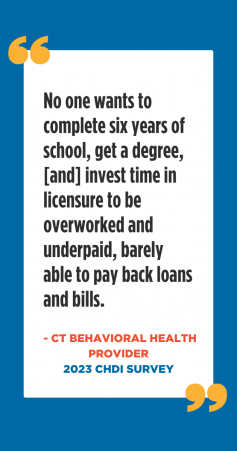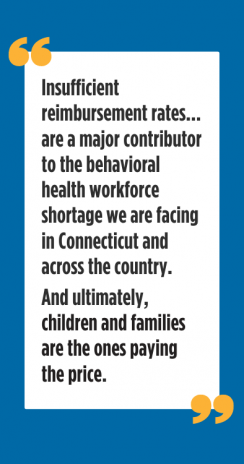
This is the second post in our special blog series taking a closer look at the impact of Connecticut’s behavioral health workforce challenges on children and families – and exploring solutions. Read the rest of the series here.
By Jeff Vanderploeg, Ph.D., President & CEO, CHDI
Imagine for a moment that you’re the owner of an asphalt company. When your state announces they’re accepting new bids to repave a ten-mile stretch of highway, you jump at the chance. A month later, you get the news: your company’s bid was selected!
There are just a few catches. First, they want ten miles of highway paved, but they can only pay you for five. Second, they’re going to pay the same amount as they paid for a five-mile stretch of highway you paved ten years ago. Finally, they would like you to collect donations and fundraise from the public so that you can pave the remaining five miles at your own cost.
Uh… what?!
Can you imagine a single asphalt company owner who would agree to this deal? As a small business owner, you need to pay your workers a competitive rate, offer raises and benefits, and cover your office rent and utilities, among other expenses. If you start accepting work that doesn’t even cover your costs, you’ll be out of business before you know it.
But what if you knew that yours is the only company in the region that can do this job, and if you don’t take it, there will be more car accidents on that stretch of deteriorating highway?
This is precisely the kind of dilemma currently facing behavioral health agencies serving Connecticut's children, youth, and families.
And here’s the amazing thing: these agencies accept the equivalent of the above deal year after year! Why? Because they know that they’re providing essential services to children and families in desperate need. Amidst rising rates of youth behavioral health challenges, these providers are helping kids recover from trauma, depression, anxiety, addiction, and other challenges. And for far too long, we’ve expected them to keep offering these vital services to growing numbers of children without enough resources to cover their full costs.
For years now, behavioral health providers have been telling policymakers that the public and private insurance reimbursement rates for their services have not kept pace with inflation or the full cost of providing high-quality care. Last year, CHDI reported that Connecticut’s Medicaid reimbursement rates would have had to increase by 23% over the last ten years just to keep up with inflation. 
But it turns out the situation is much more dire. A new study of Medicaid reimbursement rates, released earlier this month by the state Department of Social Services (DSS), has revealed that Connecticut’s rates for behavioral health are alarmingly low compared to similar states.
When compared to the averages from five “peer” states - Maine, Massachusetts, New Jersey, New York, and Oregon - the DSS study found that Connecticut rates for selected behavioral health services averaged just 62% of the five-state average. In fact, for 42% of the behavioral health services analyzed, rates were less than half of the five-state average.
In surveys conducted last year to inform a strategic plan to address Connecticut’s behavioral health workforce shortage, low rates and their impact on salaries were among the top challenges cited by the nonprofit community-based providers who serve the state’s highest-need children and families.
As in our hypothetical highway-paving scenario, many agencies say that reimbursement rates are far below the cost of providing services – and have been that way for years. As a result, many agencies cannot pay clinicians sufficiently to sustain current staffing levels, let alone hire new staff to support the growing need.
“I have worked in agencies where intakes keep coming, no caps on caseloads, back-to-back appointments with little time to plan,” shared one provider in the survey. “No one wants to complete six years of school, get a degree, [and] invest time in licensure to be overworked and underpaid, barely able to pay back loans and bills.”
As a result of low rates, many providers have either stopped accepting Medicaid or insurance altogether, gone into private practice, or both. In a survey of psychologists in Connecticut, many reported dropping at least one insurance panel in the prior year due to low rates. Even practices that are in-network with some commercial insurance plans often do not take Medicaid due to low reimbursement rates. For example, a 2021 government analysis found that only 46% of psychiatrists nationwide accepted Medicaid, compared to 74% across all specialties.
Low reimbursement rates have driven many clinicians away from community-based organizations and into private behavioral health practices where there is higher pay, less administrative work, more schedule flexibility, and smaller caseloads. The average salary range for clinicians with similar qualifications is $58,839 - $72,905 at nonprofit behavioral health agencies, compared to an average private practice salary range of $82,400 - $117,350 (based on an analysis of online job postings completed for the strategic plan).
Clinicians moving from community-based agencies to private practices can further widen gaps in access to care. Because private practices are not required to take insurance, the costs can be out of reach for the majority of families who depend on insurance to help cover costs.
Around the country, more states are raising rates and changing how they set and adjust rates over time. According to a nationwide 2023 Kaiser Family Foundation survey, 28 of 44 states reported either implementing Medicaid rate increases for behavioral health services in FY 2022 or planning to do so in FY 2023.
In Maine, for example, the state’s Medicaid authority has transformed its rate-setting system to address immediate needs and develop a systematic, transparent process to review and increase rates over time based on inflation and other factors. Oregon has also been rolling out comprehensive changes, including a Medicaid rate increase of up to 30% for behavioral health providers in 2023.(Learn more about what other states are doing in the strategic plan).
Connecticut has not increased Medicaid rates across the board since 2007 – that’s seventeen years without a raise for many services. Legislators considered raising rates last year but postponed doing so for most services (there were small increases for some in-home, inpatient, and substance use services) until the DSS rate study could be completed.
Unfortunately, increases were not included in the Governor’s initial budget proposal this year. But now that we have the data proving what providers have been shouting from the rooftops, legislators still have time to act. And while more data is always helpful, Connecticut’s children and families shouldn’t have to wait until the next phase of the rate study is completed for this work to begin.
Insufficient reimbursement rates that prevent agencies from paying competitive salaries are a major contributor to the behavioral health workforce shortage we are facing in Connecticut and across the country. And ultimately, Connecticut’s children and families are the ones paying the price. Families are kept waiting for care while their children’s symptoms worsen, which can result in a need for higher, more costly levels of care (e.g., inpatient hospitalization). 
“We had to wait over one year for a developmental evaluation and had to drive an hour-and-a-half for it,” shared one parent who responded to last year’s survey, adding, “We could not find a play therapist within one hour of our home.”
Families of color, who, on average, hold less wealth than white families and are disproportionately served by Medicaid/HUSKY (see a table of coverage type by race and ethnicity), are particularly impacted by workforce shortages in nonprofit agencies. It also places an undue burden on families whose children have more severe behavioral health conditions and disabilities that require intensive or longer-term services.
“[More funding] could greatly increase access to care by allowing for more adequate staffing,” a nonprofit provider in Danbury wrote in response to last year’s survey. “The child guidance clinics are where many of the neediest families and children can access services.”
With rising need among youth and a growing exodus of clinicians from community-based agencies, the strategic plan’s first recommendation is to increase Medicaid reimbursement rates as soon as possible, perhaps by matching or exceeding the five-state averages in the new DSS rate study.
But over the longer term, it will be equally important to develop a systematic, transparent, and responsive rate-setting process that can keep up with inflation and labor market changes over time and better reflect the full costs of providing high-quality care.
To start, tying reimbursement rate increases to the rate of inflation would go a long way toward shrinking the gap. The new DSS rate study report also includes some recommendations for how the state could approach this process, such as basing rates on a percentage of current Medicare rates (not rates from 2007) and reviewing rates at least every five years.
It's also important to remember that most insurance plans reimburse only the actual time spent treating clients/patients, not the significant administrative and collaborative work that happens between sessions, particularly in children’s behavioral health. DSS and other state agencies are currently developing strategies to cover some of these additional costs (an alternative payment or value-based model is one possible strategy).
States tend to focus on Medicaid rates because they have more control over the rate-setting process, but disparities in private insurance rates should also be addressed. To ensure comparable rates between behavioral health and medical services, as required by federal parity law, stronger enforcement and oversight of commercial insurance rates is needed.
Not surprisingly, one of the most common questions CHDI has received since releasing the workforce strategic plan is “How much will it cost?” Thanks to the new DSS rate study, we now have some cost estimates for a variety of scenarios the state might consider. The truth is, after seventeen years without broad increases, catching up won’t be cheap.
But over the long term, the cost of maintaining the status quo – as measured in dollars, in reduced access to critical services, in erosion of our behavioral health system, and in unnecessary suffering - will be higher than the cost of taking action now. Connecticut children and families cannot afford to wait.
To learn more about the state's new Medicaid rate study, the relationship between reimbursement rates and the behavioral health workforce shortage, and the strategic plan to address this crisis, here are some resources:
New DSS Rate Study (Phase 1) (CT Department of Social Services, February 2024)
“Report: CT Medicaid Underpays Many Health Care Providers.” (CT Mirror, 2/19/24)
“Connecticut Nonprofits Struggle to Find Staff, Adequate Funding for Health Services.” (CT Examiner, 9/14/23)
Who Will Do the Work? Strengthening the Children’s Behavioral Health Workforce to Meet Families’ Increasing Behavioral Health Needs (CHDI Policy Brief, 2022)
How Differences in Medicaid, Medicare, and Commercial Health Insurance Payment Rates Impact Access, Health Equity, and Cost (Commonwealth Fund, 2022)
Strategic Plan to Strengthen Connecticut's Behavioral Health Workforce for Children, Youth, and Families (CHDI, 2023)
Top photo credit: alexandrumagurean from Getty Images Signature via Canva Pro

|
Jeff Vanderploeg, Ph.D. - President & CEO jvanderploeg@chdi.org |